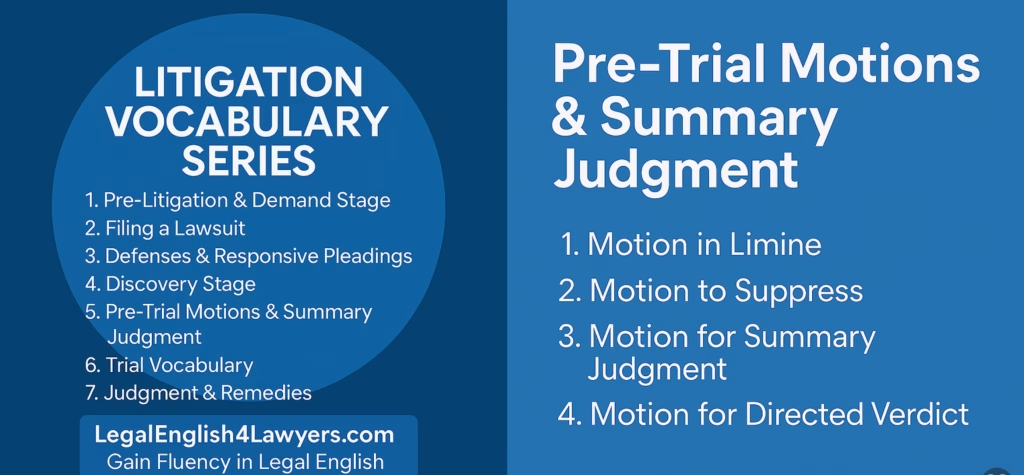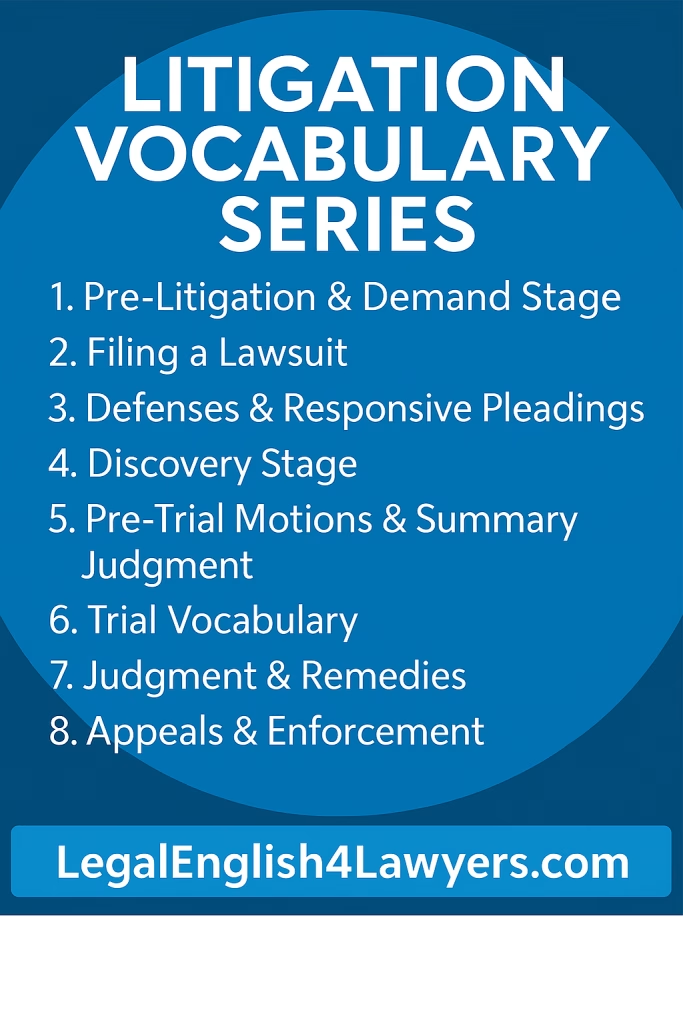
Ready to Go Deeper?
At LegalEnglish4Lawyers.com, we don’t just define legal terms — we explore them through real documents, client scenarios, and clause-by-clause analysis.
Click here to see a quick view of all posts.
-
Pre-Trial Motions and Summary Judgment-Essential Litigation Vocabulary-Part 5

Introduction To Pre-Trial Motions and Summary Judgment.
As litigation approaches trial, pre-trial motions become a central strategic tool. This phase is about shaping what the judge or jury will hear, what evidence will be admitted, and even whether a trial is necessary at all. For attorneys—especially those working internationally or in a second language—fluency in Legal English for Pre-Trial Motions is essential. This fifth installment in our 8-part Litigation Vocabulary Series focuses on the most important vocabulary lawyers need to communicate with confidence and clarity during this critical stage.
Pre-Trail Motions and Summary Judgement Vocabulary
1. Motion in Limine
Definition:
A pre-trial request to exclude certain evidence from being introduced during the trial.
Example:
Plaintiff filed a motion in limine to prevent the defendant from referencing the plaintiff’s prior lawsuits.
Legal Context:
This motion allows lawyers to argue that certain evidence is inadmissible—because it is irrelevant, prejudicial, or misleading—before it’s ever presented to the jury. The judge decides whether the evidence should be excluded or admitted conditionally.
- Inadmissible evidence: Information that cannot be presented in court due to legal rules.
- Prejudicial: Likely to unfairly influence the jury’s decision.
2. Summary Judgment
Definition:
A request asking the court to decide a case or specific claims without a trial, on the basis that there are no disputed material facts.
Example:
Defendant moved for summary judgment, arguing that the facts were undisputed and the law clearly supported dismissal.
Legal Context:
Summary judgment allows the court to resolve legal disputes without the cost and delay of trial. It is often filed after discovery and relies heavily on affidavits, declarations, and deposition transcripts to demonstrate that no factual disputes remain.
- Affidavit: A written statement of facts confirmed by oath or affirmation.
- Deposition transcript: A written record of sworn out-of-court testimony.
3. Pre-Trial Conference
Definition:
A court-ordered meeting between the parties (and sometimes the judge) to discuss trial readiness and streamline issues before trial.
Example:
At the pre-trial conference, both parties agreed to limit expert testimony to four witnesses.
Legal Context:
These conferences promote efficiency by finalizing the list of witnesses, exhibits, and unresolved issues. The court may issue a pre-trial order, which governs the conduct of trial and can limit the introduction of previously undisclosed material.
- Pre-trial order: A formal document issued by the court outlining agreed procedures, issues, and evidence.
4. Judicial Notice
Definition:
A court’s acceptance of a fact as true without requiring formal evidence.
Example:
The judge took judicial notice of the fact that January 1 is a federal holiday.
Legal Context:
This doctrine allows courts to recognize common facts that are not reasonably disputed, such as public laws or dates. Judicial notice can be used strategically to bypass unnecessary proof for obvious or well-known facts.
- Doctrine: A legal principle developed through precedent or statutory authority.
5. Stipulation
Definition:
An agreement between opposing parties on a particular fact or legal issue.
Example:
The parties entered a stipulation that the contract was signed on March 12.
Legal Context:
Stipulations streamline litigation by reducing the number of facts that need to be proven at trial. They are binding and can simplify motions, pre-trial planning, and jury instructions.
- Binding: Legally enforceable and not subject to dispute unless withdrawn by both parties.
6. Daubert Challenge
Definition:
A motion to exclude expert witness testimony that does not meet standards of relevance and reliability.
Example:
The defense filed a Daubert challenge to prevent the plaintiff’s expert from testifying on economic damages.
Legal Context:
Originating from U.S. Supreme Court case Daubert v. Merrell Dow Pharmaceuticals, this motion tests whether an expert’s methods are scientifically valid and applicable to the case. Judges act as gatekeepers to ensure only qualified expert testimony reaches the jury.
- Expert witness: A person qualified by knowledge, skill, experience, or education to offer opinions in court.
- Gatekeeper role: The judge’s responsibility to ensure that expert evidence meets minimum reliability standards.
7. Motion to Exclude
Definition:
A request to prevent specific evidence or testimony from being introduced at trial.
Example:
Plaintiff filed a motion to exclude surveillance footage that had not been disclosed during discovery.
Legal Context:
This motion is typically based on violations of discovery obligations or rules of evidence. It ensures fairness by discouraging trial by surprise, where previously undisclosed material is used at the last moment.
- Trial by surprise: The use of unexpected or undisclosed evidence that disadvantages the opposing party.
8. Motion to Strike
Definition:
A request to remove improper or irrelevant parts of a pleading from the court record.
Example:
Defendant filed a motion to strike inflammatory language from the complaint’s introductory paragraph.
Legal Context:
This motion cleans up the legal record and ensures the jury is not exposed to legally inappropriate statements. It may also apply to evidence presented at trial, such as testimony that violates prior rulings.
- Pleading: A formal written statement of a party’s claims or defenses.
More information on motions to strike.
Conclusion: Pre-Trial Motions & Summary Judgement
Pre-trial motions are where legal arguments crystallize, and cases are often won or lost before they reach a jury. Fluency in the terminology of this stage is not just about vocabulary—it’s about understanding the legal strategy and communicating with authority. Whether negotiating stipulations, drafting a motion in limine, or preparing for summary judgment, Legal English proficiency at this phase is essential.
Build Your Legal English Skills with Confidence
Clear, confident communication is essential for every lawyer. Whether you’re working on conversations, meetings, or documents, strong Legal English helps you succeed. Book a free coaching session and start building skills you can use in any area of legal practice.
Disclaimer
DISCLAIMER: The content provided herein is only for discussion purposes and may contain errors. The reader is responsible to confirm the accuracy of the information provided. The content does not constitute legal or professional advice. We disclaim any liability for any loss or damage incurred directly or indirectly from the use of this information.
-
Discovery Phase-Essential Litigation Vocabulary-Part 4

Introduction To The Discovery Phase.
The discovery phase is often the longest and most complex part of litigation. It is the stage where both parties exchange information, investigate facts, and gather evidence that will shape their legal strategies.
Mastery of the litigation vocabulary language used during discovery is critical—not only to comply with procedural rules but also to frame disputes, anticipate defenses, and build persuasive narratives.
This is Part 4 of our 8-part Litigation Vocabulary Series, designed to help lawyers and law students build fluency in Legal English across each phase of a lawsuit.
Pre-Litigation Stage -Litigation Vocabulary Series (Part 1),
Filing a Lawsuit – Litigation Vocabulary Series (Part 2)
Defenses & Responsive Pleadings -Litigation Vocabulary Series (Part 3)
Discovery Phase Litigation Vocabulary Terms
1. Discovery
Definition:
The formal process by which parties to a lawsuit obtain information, documents, and evidence from each other and from third parties.
Example:
The court set deadlines for written discovery and depositions to be completed before trial.
Legal Context:
Discovery ensures transparency and fairness by allowing both sides access to the facts necessary to prove or defend their claims. It includes various tools such as interrogatories, requests for production, requests for admission, and depositions, all bounded by the principles of relevance and proportionality.
- Relevance: The tendency of evidence to affect the probability of a fact being true.
- Proportionality: Ensuring discovery efforts are reasonable compared to the importance of the issues and the burden of producing information.
2. Interrogatories
Definition:
Written questions formally submitted by one party to another, requiring written answers under oath.
Example:
Plaintiff served interrogatories asking the defendant to identify all employees involved in the project.
Legal Context:
Interrogatories are used to obtain factual information, narrow issues, and identify witnesses or documents early in the litigation. Unlike depositions, which involve oral testimony, interrogatories allow considered, written responses that are made under penalty of perjury.
- Perjury: The criminal offense of lying under oath.
3. Requests for Production
Definition:
Formal demands for documents, electronically stored information (ESI), or tangible items relevant to the claims or defenses.
Example:
Defendant responded to a request for production by providing financial records from the past five years.
Legal Context:
Requests for production are essential to building the factual record of a case. Parties must produce materials within their possession, custody, or control. This obligation can extend to third parties if the responding party has legal access to the documents.
- Electronically Stored Information (ESI): Data or documents stored electronically, including emails, databases, and metadata.
- Possession, custody, or control: Having physical possession or the legal right to obtain the documents requested.
4. Depositions
Definition:
Out-of-court, oral questioning of a party or witness under oath, recorded for use during litigation.
Example:
Counsel took the deposition of the plaintiff’s expert witness regarding causation opinions.
Legal Context:
Depositions preserve testimony, allow for impeachment at trial, and test a witness’s credibility. A deponent (the person being questioned) must answer all non-privileged questions unless instructed otherwise by counsel. Depositions often involve objections to protect privileges without obstructing the discovery process.
- Deponent: The individual providing sworn oral testimony.
- Impeachment: Challenging the credibility or truthfulness of a witness’s testimony.
5. Requests for Admission
Definition:
Written statements asking the opposing party to admit or deny the truth of facts or the authenticity of documents.
Example:
Plaintiff served requests for admission asking Defendant to admit the existence of a signed agreement.
Legal Context:
Requests for admission narrow trial issues by confirming undisputed facts. Failure to respond within the allotted time usually results in automatic admission. These tools reduce litigation costs by limiting the number of matters that must be proven during trial.
- Authentication: Verifying that a document is genuine and what it purports to be.
6. Protective Order
Definition:
A court order limiting or restricting discovery to prevent undue burden, harassment, or the disclosure of sensitive information.
Example:
Defendant obtained a protective order restricting dissemination of confidential business records.
Legal Context:
Protective orders balance the right to discovery against the right to protect privacy, trade secrets, or privileged communications. Courts may order documents to be filed under seal, limit the scope of questioning, or bar certain disclosures altogether.
- Under seal: Filing documents privately with the court, unavailable to the public.
7. Privilege Log
Definition:
A list describing documents withheld from production on grounds of privilege without disclosing the protected information.
Example:
Defendant submitted a privilege log identifying emails withheld based on attorney-client privilege.
Legal Context:
When asserting privilege, a party must prepare a privilege log that provides enough detail to assess the claim without revealing privileged content. Common privileges include the attorney-client privilege and the work product doctrine.
- Attorney-client privilege: Protection of confidential communications between lawyer and client.
- Work product doctrine: Protection of materials prepared in anticipation of litigation.
8. Motion to Compel
Definition:
A request asking the court to order a party to respond fully to discovery requests.
Example:
Plaintiff filed a motion to compel production of internal audit reports.
Legal Context:
A motion to compel enforces discovery obligations when a party refuses or fails to produce requested information. Courts may impose sanctions for failure to comply after a motion is granted, ranging from monetary penalties to exclusion of evidence.
- Sanctions: Court-imposed penalties for violations of rules or orders.
Conclusion: Discovery Phase
Discovery is where litigation is truly built. It provides the facts, documents, and testimony that determine trial strategy and settlement value. Lawyers who master the language of discovery gain a critical advantage—communicating more persuasively with courts, clients, and opposing counsel alike. For non-native English speakers, fluency in discovery vocabulary is essential for active participation in complex litigation.
Our 8 Part Litigation Vocabulary Series
Litigation involves multiple stages, each with its own unique terminology. To help you master the vocabulary used at each stage, we’ve created detailed guides you can explore:
- Pre-Litigation Vocabulary: Investigating and Finding the Facts
- Filing a Lawsuit: Initiating Legal Action
- Defenses and Responsive Pleadings Vocabulary
- Discovery Phase Vocabulary: Evidence and Information Gathering
- Pre-Trial Motions and Summary Judgment Vocabulary
- Trial Stage Vocabulary: Presenting Your Case
- Judgment and Remedies Vocabulary
- Appeals and Enforcement Vocabulary
Each guide is designed to deepen your understanding of essential legal English at every critical point in the litigation process.
Build Your Legal English Skills with Confidence
Clear, confident communication is essential for every lawyer. Whether you’re working on conversations, meetings, or documents, strong Legal English helps you succeed. Book a free coaching session and start building skills you can use in any area of legal practice.
Disclaimer
The content provided herein is only for discussion purposes and may contain errors. The reader is responsible to confirm the accuracy of the information provided. The content does not constitute legal or professional advice. We disclaim any liability for any loss or damage incurred directly or indirectly from the use of this information.
-
Defenses & Responsive Pleadings-Essential Litigation Vocabulary-Part 3

Introduction: Defenses & Responsive Pleadings
After a lawsuit is filed, the defendant’s response becomes the first major pivot point in the litigation. This stage introduces critical tools that may limit, delay, or even extinguish the plaintiff’s claims—before the case reaches discovery or trial.
Lawyers must not only understand the procedures but also command the litigation vocabulary that governs strategic response. For international attorneys, mastering this litigation vocabulary is essential to navigating pleadings, motion practice, and procedural positioning.
This is Part 3 of our 8-part Litigation Vocabulary Series, supporting Legal English fluency at multiple phases.
Pre-Litigation Stage -Litigation Vocabulary Series (Part 1)
Filing a Lawsuit – Litigation Vocabulary Series (Part 2)
Defenses & Responsive Pleadings -Litigation Vocabulary Series (Part 3)
The Discovery Phase – Essential Litigation Vocabulary (Litigation Series Part 4)
Litigation Vocabulary Terms
1. Answer
Definition
A formal pleading in which the defendant responds to each allegation in the complaint by admitting, denying, or stating lack of knowledge.
Example
Defendant answers the complaint by admitting Paragraphs 1–3 and denying Paragraphs 4–7.
Legal Context
The answer frames the factual disputes that will proceed through litigation. It is the defendant’s first opportunity to respond on the record and shape the case’s scope. Failure to deny an allegation may result in an admission—a binding acknowledgment of the opposing party’s claim. An answer may also introduce affirmative defenses (defined below) and set up the groundwork for counterclaims or other responsive pleadings.
- Admission: A statement accepting the truth of an opposing party’s allegation.
- Pleading: A formal written submission to the court stating a party’s claims or defenses.
- Allegation: A statement of fact that a party claims to be true, subject to proof.
2. Affirmative Defense
Definition
A defense asserting facts or legal theories that, if proven, defeat or mitigate the plaintiff’s claims—even if the allegations in the complaint are true.
Example
Defendant asserts the affirmative defense of waiver, arguing that Plaintiff knowingly gave up the right to enforce the contract.
Legal Context
An affirmative defense acknowledges the conduct alleged but introduces legal or factual grounds that excuse or justify it. These defenses shift the burden of proof to the defendant and can independently bar recovery. Common examples include waiver, estoppel, unclean hands, and contributory negligence.
- Waiver: The voluntary relinquishment of a known legal right.
- Estoppel: A bar that prevents a party from asserting something contrary to what was previously established through actions or representations.
- Unclean hands: A doctrine that denies relief to a party who has engaged in unethical conduct related to the subject of the lawsuit.
- Contributory negligence: A defense arguing that the plaintiff’s own negligence contributed to the harm and should reduce or bar recovery.
3. Motion to Dismiss
Definition
A request asking the court to terminate a case based on legal deficiencies in the complaint.
Example
Defendant moves to dismiss on the grounds that the complaint fails to state a valid legal claim.
Legal Context
A motion to dismiss challenges the legal sufficiency of the plaintiff’s pleadings without addressing the merits of the case. It may argue that the court lacks subject matter jurisdiction, that the plaintiff has not alleged facts that constitute a cause of action, or that the venue is improper.
- Subject matter jurisdiction: The authority of a court to hear a particular type of case.
- Cause of action: A set of facts giving rise to a legally enforceable claim.
- Improper venue: A procedural objection asserting that the case was filed in the wrong court location.
4. Counterclaim
Definition
A legal claim brought by the defendant against the plaintiff in the same proceeding.
Example
In response to the breach of contract claim, Defendant asserts a counterclaim for fraud in the inducement.
Legal Context
A counterclaim enables the defendant to go on the offensive by asserting rights or damages stemming from the same transaction or a related one. It may be compulsory (required if it arises out of the same events) or permissive (optional, based on unrelated issues). When included, it is treated as an independent claim and must satisfy the same standards of pleading and proof.
- Fraud in the inducement: A claim that a party was tricked into entering a contract due to false representations.
- Compulsory counterclaim: A claim that must be raised in the current lawsuit or be forfeited.
- Permissive counterclaim: A claim that may be raised in the current case or in a separate action.
5. Crossclaim
Definition
A claim brought by one defendant against another defendant within the same lawsuit.
Example
Defendant A crossclaims against Defendant B for indemnity, arguing that B is ultimately responsible for any damages awarded.
Legal Context
Crossclaims are procedural devices used when co-defendants have disputes related to the plaintiff’s claim. They allow one defendant to assert legal responsibility against another, preserving judicial efficiency and ensuring aligned fact-finding. Crossclaims are usually based on shared liability, indemnification, or contribution.
- Indemnity: A contractual or equitable obligation of one party to cover the losses of another.
- Contribution: The right of a party who pays more than their share of damages to recover the excess from others.
6. Third-Party Complaint
Definition
A pleading filed by the defendant to bring a new party into the lawsuit, alleging that the third party is liable for some or all of the plaintiff’s claim.
Example
Defendant files a third-party complaint against ABC Co., alleging that it was responsible for the defective product.
Legal Context
A third-party complaint, often referred to as impleader, allows the defendant to shift liability to another party. This strategy consolidates related claims and avoids duplicative litigation. The third party, once joined, becomes a new litigant and must respond to the allegations as if initially named.
- Impleader: A procedural mechanism allowing a defending party to bring in someone else who may be liable.
7. Demurrer
Definition
A pleading challenging the legal sufficiency of the opposing party’s pleading, assuming all facts are true.
Example
Defendant files a demurrer arguing that the facts alleged do not support a legally recognizable claim.
Legal Context
Although largely replaced by other mechanisms in many jurisdictions, the demurrer remains a distinct term in some state courts. It focuses purely on the legal adequacy of the claim and does not dispute the underlying facts. If granted, the pleading is dismissed without fact-finding or discovery.
- Legal sufficiency: The adequacy of the allegations to support a legal claim.
8. Reply
Definition
A formal response filed by the plaintiff to address new matters raised in the defendant’s answer.
Example
Plaintiff files a reply denying the affirmative defense of estoppel and reasserts the right to relief.
Legal Context
A reply is not always required but may be ordered or permitted when the defendant raises new legal theories or defenses. Replies allow the plaintiff to clarify their position, avoid implied admissions, and preserve factual disputes. Though less common than other pleadings, a reply can be vital when the defendant introduces complex affirmative defenses or counterclaims.
Conclusion
The stage of responsive pleadings is where litigation becomes strategically textured. Through answers, affirmative defenses, and various responsive claims, defendants can shift the momentum of the case, introduce new issues, or even seek dismissal outright. For non-native English speakers working in litigation or cross-border disputes, fluency in this litigation vocabulary unlocks clearer communication, faster drafting, and more persuasive advocacy.
Improve Your Legal English Skills With Personalized Tutoring
Want to see how these terms function in real court documents? Book a free coaching session and practice with personalized feedback.
Disclaimer
The content provided herein is only for discussion purposes and may contain errors. The reader is responsible to confirm the accuracy of the information provided. The content does not constitute legal or professional advice. We disclaim any liability for any loss or damage incurred directly or indirectly from the use of this information.

